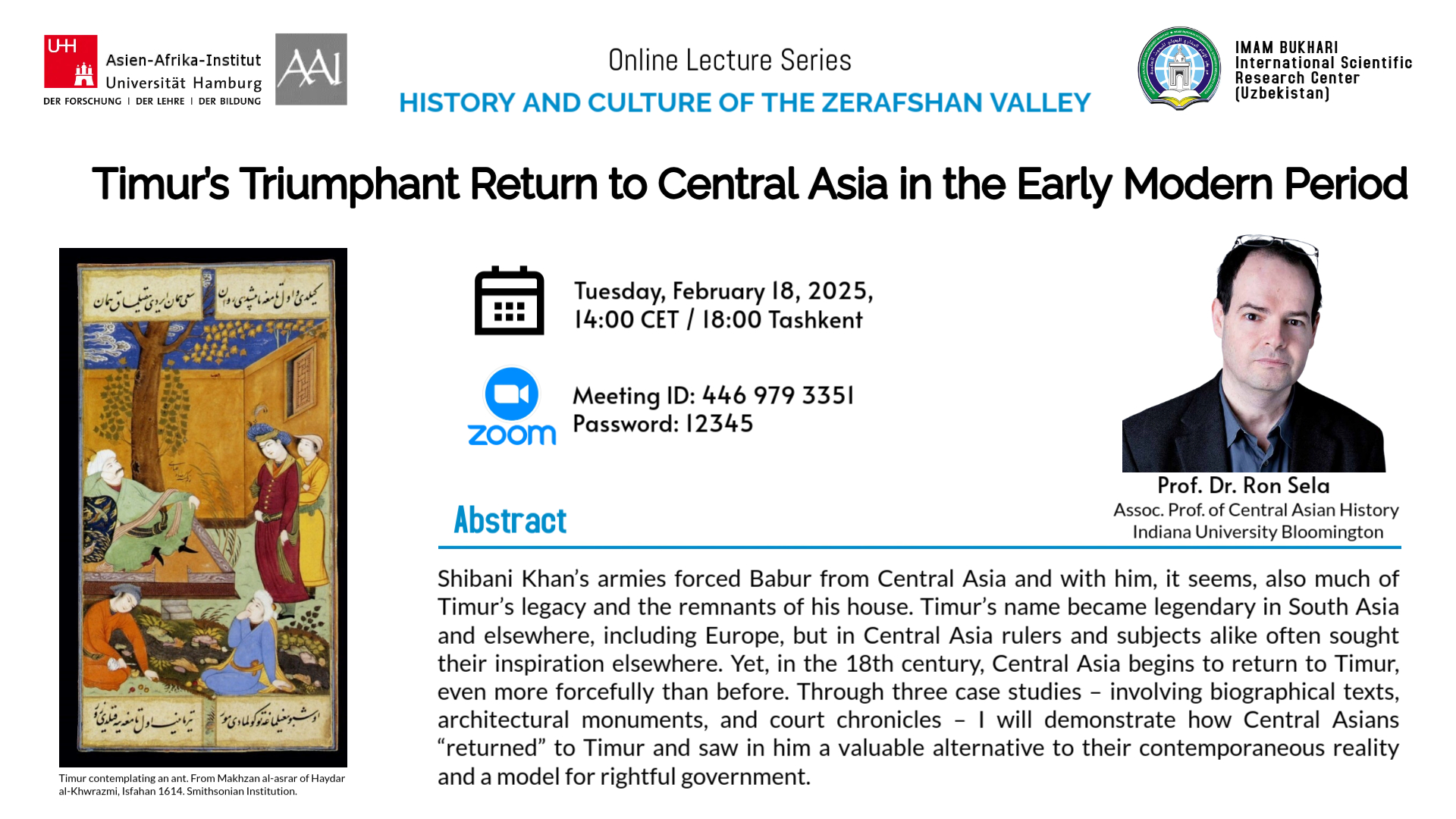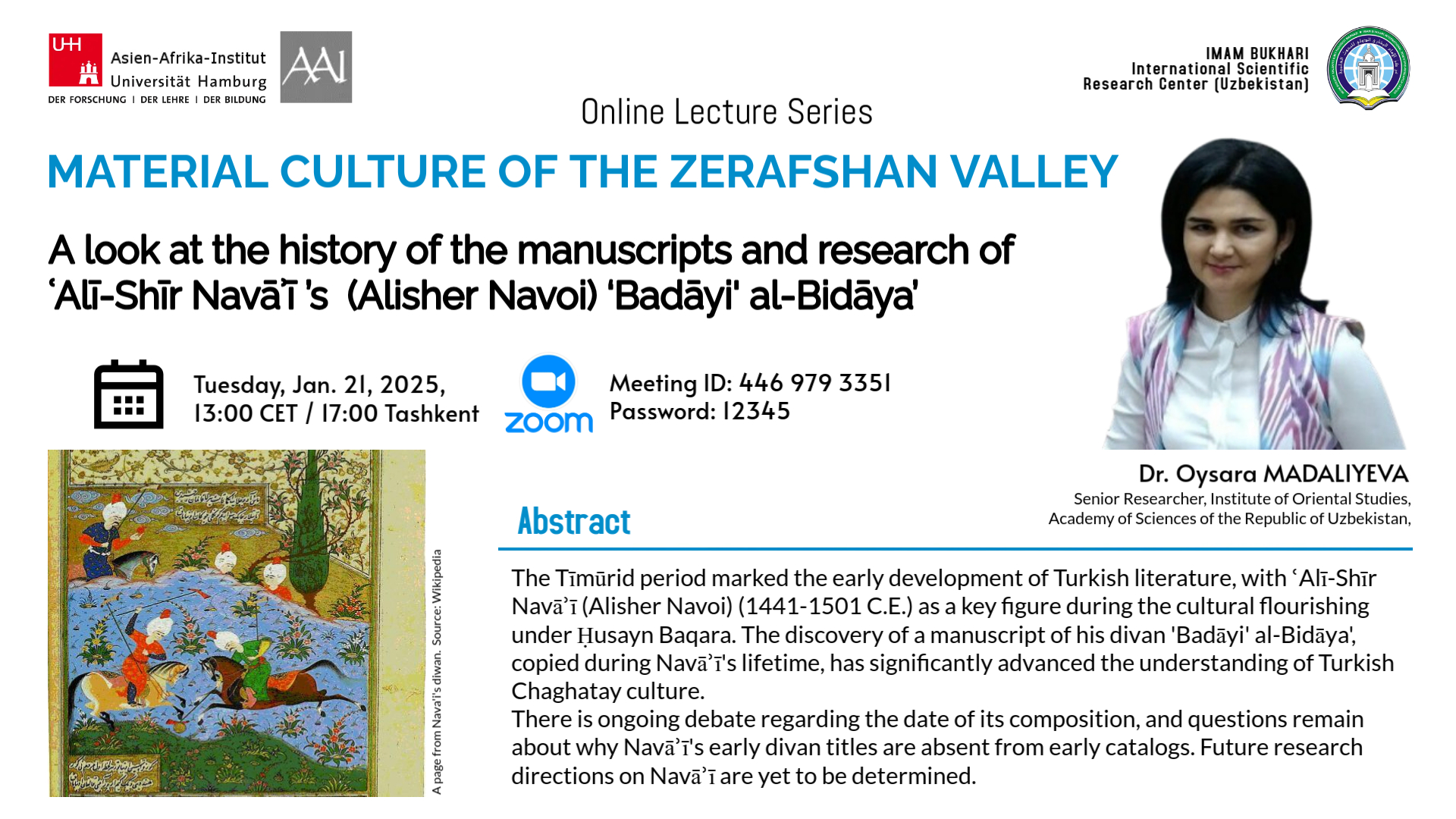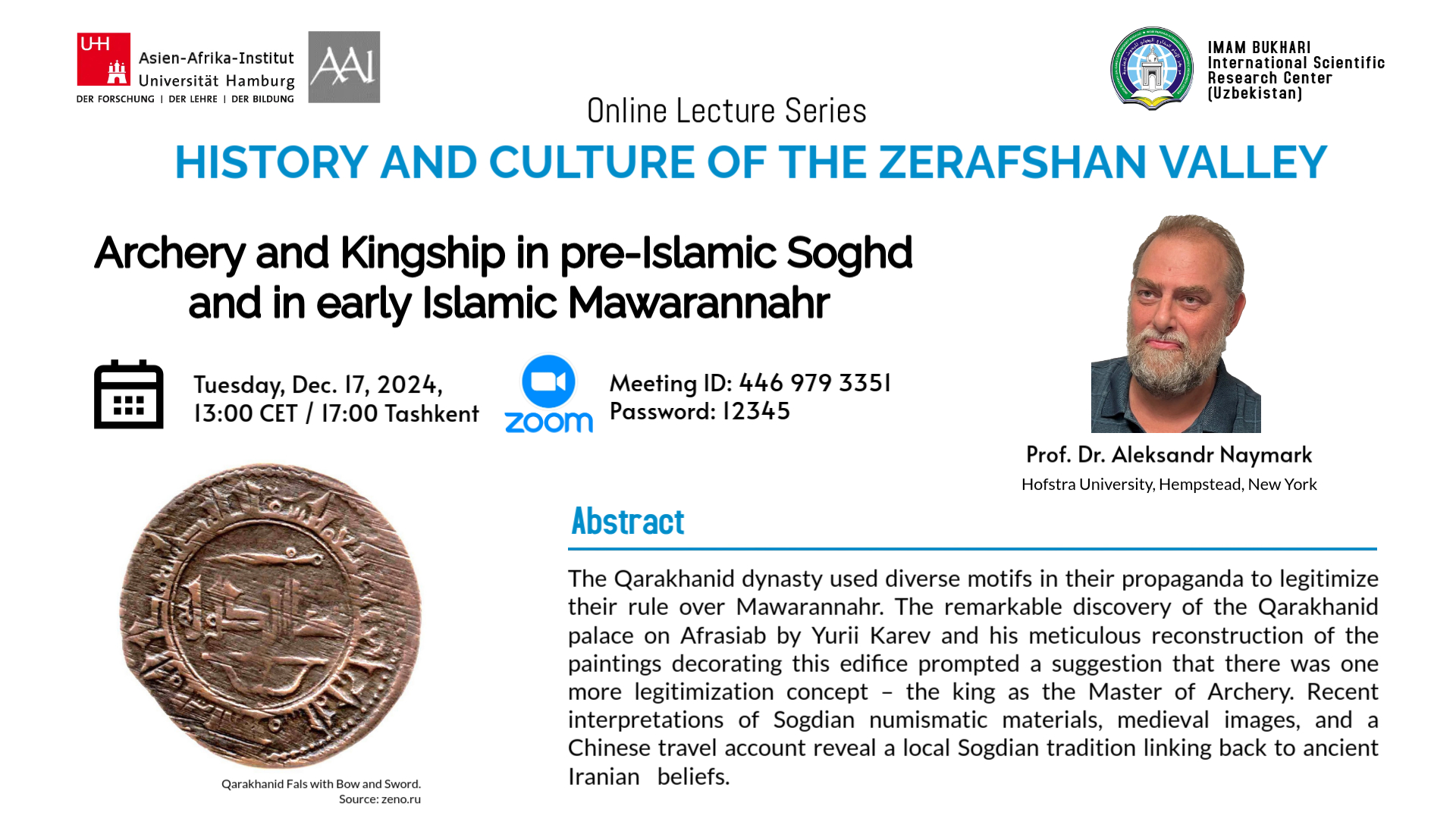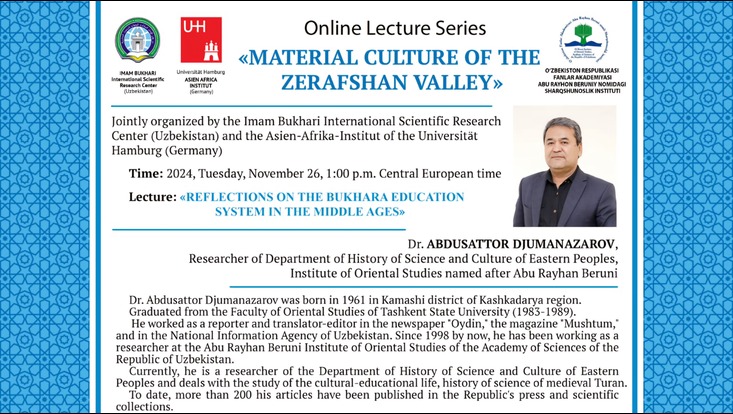8th Lecture Series on the History and Culture of Central Asia
During the winter term 2024/25, the eighth
Lecture Series on the History and Culture of Central Asia
will take place. As usual the series consists of four lectures and takes place online via Zoom.
Zoom credentials:
Meeting ID: 446 979 3351
Password: 12345
Or click here for the direct link of the zoom meeting.
February 18, 2025 - Ron Sela - "Timur’s Triumphant Return to Central Asia in the Early Modern Period"

We cordially invite to our lecture of this winter term's series on the history and culture of the Zerafshan Valley. The lecture will be presented by Prof. Dr. Ron Sela, Associate Professor of Central Asian history at Indiana University’s Hamilton Lugar School of Global and International Studies.
- Topic: Timur’s Triumphant Return to Central Asia in the Early Modern Period
- Date: February 18th, 2025, 14:00 CET
- Place: online via ZOOM
Abstract:
Shibani Khan’s armies forced Babur from Central Asia and with him, it seems, also much of Timur’s legacy and the remnants of his house. Timur’s name became legendary in South Asia and elsewhere, including Europe, but in Central Asia rulers and subjects alike often sought their inspiration elsewhere. Yet, in the 18th century, Central Asia begins to return to Timur, even more forcefully than before. Through three case studies – involving biographical texts, architectural monuments, and court chronicles – I will demonstrate how Central Asians “returned” to Timur and saw in him a valuable alternative to their contemporaneous reality and a model for rightful government.
About the speaker:
Ron Sela is an Associate Professor of Central Asian history at Indiana University’s Hamilton Lugar School of Global and International Studies, where he also serves as Director of the Islamic Studies Program and as Director of the Sinor Research Institute for Inner Asian Studies. A former student of Yuri Bregel and Devin DeWeese, Dr. Sela is the author of multiple books and articles on the history of Central Asia, including The Legendary Biographies of Tamerlane: Islam and Heroic Apocrypha in Central Asia (Cambridge University Press, 2011).
In order to participate, please click here or use the following Zoom credentials:
Meeting ID: 446 979 3351
Password: 12345
January 21, 2025 - Oysara Madaliyeva - "A look at the history of the manuscripts and research of ʿAlī-Shīr Navāʾī’s (Alisher Navoi) ‘Badāyi' al-Bidāya’"

We cordially invite to the third lecture of this winter term series on the history and culture of the Zerafshan Valley. The series is jointly organized by Prof. Dr. Stefan Heidemann, Department of Islamic Studies at the Asien-Afrika-Institut (Universität Hamburg), and Dr. Shovosil Ziyodov, director of the Imam Bukhari International Scientific Research Center in Tashkent, Uzbekistan.
The subsequent lecture will be presented by Dr. Oysara MADALIYEVA, Senior Researcher, Institute of Oriental Studies, Academy of Sciences of the Republic of Uzbekistan
- Topic: A look at the history of the manuscripts and research of ʿAlī-Shīr Navāʾī’s (Alisher Navoi) Badāyi' al-Bidāya
- Date: January 21th, 2025, 13:00 CET
- Place: online via ZOOM
Abstract:
The Tīmūrid period was the formative period of Turkish literature. One of its earliest and most influential protagonists was the Tīmūrid poet ʿAlī-Shīr Navāʾī (Alisher Navoi) (1441-1501 C.E.). He lived in the period of cultural flourishing under Ḥusayn Baqara. The discovery of a manuscript of his divan Badāyiʿ al-Bidāya (Badoyi ul-Bidoya), copied during Navāʾī's lifetime, was a major step forward in the study of Turkish Chaghatay culture.
A debate arose about the date of composition of Badāyiʿ al-Bidāya. The presentation also discusses other noteworthy aspects. Why are the titles of Navāʾī's early divans missing from the earliest catalogs
Profile of the lecturer:
Dr. Oysara Rustamovna Madalieva is a senior researcher and associate professor at the Abu Rayhon Beruni Institute of Oriental Studies of the Academy of Sciences of the Republic of Uzbekistan. Oysara Madalieva received her Ph.D. from the Tashkent State Institute of Oriental Studies in 2021. Her scientific interests focus on medieval Turkic-Persian literary manuscripts. In recent years, she has been involved in numerous projects on Persian and Chagatai-Turkic manuscripts.
She has co-authored our catalogs, three indexes, and a book album. Oysara Madalieva's current research focuses on the history of ʿAlī-Shīr Navāʾī's texts and their historical and literary context.
She is a member of CESS, CERF, Step Sisters and WOSCU. She is also a member of the editorial board of the journal "Golden Letters" of the Tashkent State University of Uzbek Language and Literature (2023) and deputy editor-in-chief of the journal "Social Sciences in Uzbekistan" of the Academy of Sciences of Uzbekistan (2024).
In order to participate, please click here or use the following Zoom credentials:
Meeting ID: 446 979 3351
Password: 12345
December 17, 2024 - Aleksandr Naymark - "Archery and Kingship in Pre-Islamic Soghd and in Early Islamic Mawarannahr"

The second lecture in the winter term's series on the material culture of the Zerafshan Valley was presented by Prof. Dr. Aleksandr Naymark, Professor of Fine Arts, Design, and Art History at Hofstra University in Hempstead, New York.
- Subject: Archery and Kingship in pre-Islamic Soghd and in early Islamic Mawarannahr
- Date: December 17th, 2024, 13:00 CET
- Place: online via ZOOM
Abstract:
Coins and written sources recorded several different motifs in Qarakhanid propaganda meant to legitimize this dynasty’s rule over Mawarannahr. To Islamic population these rulers presented themselves as zealous Muslims. For Turks they were Khāqāniya or al-Muluk al-Khāniya al-Atrāk. With Persians they tried to be Āl-e Afrāsiāb “the house of Afrasiab”. Qarakhanid ruler could call himself malik al-mashriq wa’l-Ṣin – “the king of East and China”, and occasionally claimed to be Ṭamghach or Tabgach Khan, i.e. the Emperor of China. Yet the remarkable discovery of the Qarakhanid palace on Afrasiab by Yurii Karev and his meticulous reconstruction of the paintings decorating this edifice prompted a suggestion that there was one more legitimization concept – the king as the Master of Archery. Recently re-interpreted Sogdian numismatic materials and some early Mediaeval images combined with the information of a Chinese travel account allow us to discern in the images of the Afrasiab Qarakhanid palace a local Sogdian tradition that can be traced even further back to ancient Iranian beliefs.
Profile of the lecturer:
Native of Tashkent, Uzbekistan, Aleksandr Naymark was trained as an archaeologist and historian at Tashkent and then Moscow Universities. From 1983 to 1991 he worked at the Moscow Museum of Oriental Art directing excavation projects in Central Asia. In 1992 he enrolled at the Department of Centra Eurasian Studies at Indiana University, Bloomington, eventually receiving double Ph.D. in Central Eurasian Studies and Art History. In 1993 he studied at the summer seminar at the American Numismatic Society. As a Horstman Fellow he was in 1997-1999 affiliated with the Eurasian Department of the German Archaeological in Institute in Berlin. For the last 25 years Dr. Naymark has been teaching at Hofstra University as a Professor of Art History and the Director of Middle Eastern and Central Asian Program. He also taught at Columbia University in New York and Humboldt University in Berlin and held Shama Fellowship in Middle Eastern Numismatics and Epigraphy at Oxford University three times. Professor Naymark publishes on various aspects Central Asian art, archaeology, and numismatics.
November 16, 2024 - Abdusattor Djumanazarov - "Reflections on the Bukhara Education System in the Middle Ages"

Since the winter semester of 2020/2021, the İmam Bukhari International Scientific Research Center, in collaboration with the Department of Islamic Studies at the Asien-Afrika-Institut (Universität Hamburg) organizes a joint lecture series on the history and culture of Central Asia.
This term's series kicked off on November 26th, 2024 with the lecture of Dr. Abdusattor Djumanazarov, Researcher of the Department of the History of Science and Culture of Eastern People at the Institute of Oriental Studies named after Abu Rayhan Beruni on "Reflections on the Bukhara Education System in the Middle Ages"
Abstract:
This presentation is devoted to the history of Bukhara, its educational system and its madrasah institutes. The research on this topic began at the end of the 20th century. At the first stage of the research it was recognized that from the beginning of the 9th to the twentieth century about 350 higher educational institutions of various academic levels, libraries and hundreds of schools operated in the city and adjacent districts of Bukhara.
Profile of the lecturer:
Dr. Abdusattor Djumanazarov was born in 1961 in Kamashi district of Kashkadarya region. He graduated from the Faculty of Oriental Studies of Tashkent State University in 1989. At first he worked as a reporter and translator-editor in the newspaper "Oydin", the magazine "Mushtim" and in the National Information Agency of Uzbekistan. Since 1998 he has been working as a researcher at the Abu Rayhan Beruni Institute of Oriental Studies of the Academy of Sciences of the Republic of Uzbekistan. Currently, he is studying the cultural-educational life and the history of science of medieval Turan, the Turkic-speaking Central Asia. To date, more than 200 of his articles have been published in the press and scientific collections.
